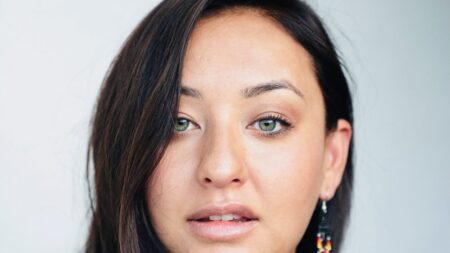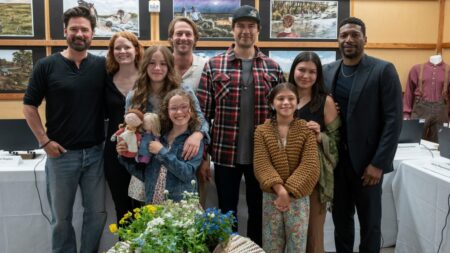Oscar-winning “Flow” by Latvia’s Gints Zilbalodis brought Baltic animation to new heights. Now, local creators are figuring out how to benefit from the aftermath of its success.
“Sometimes, big fate blesses small culture. But whether a single achievement can be used to make conclusions about the entire field, that will only become clear over time,” says Peep Pedmanson, Estonian Film Institute Animation Film Commissioner.
“There’re those who follow trends and those who create them. Estonian animation belongs to the latter. When it emerged within the Soviet Union, it immediately moved away from the mainstream. The creators were too individualistic.” And yet, there’s been something uniting them: a style that treats the audience “not as a passive object, but as an equal partner.”
“There’s that special ‘something,’ which seeps into us along with the mist of our forests and bogs. The Baltic countries are small, and Estonia is the smallest among them. In the swirling currents of global trends, holding onto our identity is harder for us than for larger cultures – but we work at it every day.”
As argued by Aurelia Aasa, founder of AAA Creative, Baltic animation has already been a “key player and trendsetter” on the international festival circuit for a while.
“Especially in the short form,” she says. “Coming from small countries can make it harder to stand out. ‘Sierra’ remains the only Estonian film on the Criterion Channel. But smallness can be a superpower, allowing us to move quickly and bring fresh perspectives.”
Oscar-shortlisted Estonian director Sander Joon will follow “Sierra” with short “Hair of Hare” about an architect whose beard escapes – as a hare. “I’ve been inspired by hares, Pippi Longstocking and architecture. I’m chasing creative freedom and I’m so happy and humbled that it seems to shine through,” he teases.
According to Kalev Tamm, producer at Eesti Joonisfilm – now bringing “Luna Rossa” to Annecy – there’s a growing interest among Estonian creators in making feature-length animated films, however, “though the challenge lies in putting together the right financing models.”
“I wouldn’t necessarily connect this to ‘Flow,’ as many of these projects were already in development, but it might reflect a broader shift in ambition and momentum within the field. Estonian animation has a strong auteur tradition, characterized by sharp, surreal tones and contemplative substance.”
Marianne Ostrat is bringing “Saima: Scenes from a Midlife Crisis” to Annecy’s MIFA: the first animated feature by Chintis Lundgren (from Estonia) and Draško Ivezić. It’s an “incredibly interesting, inspiring, and hopeful” moment to produce and develop animated feature in Estonia and across all the Baltics, she notes.
“Over the past decade, several new indie studios have emerged, but we are all building on this profound, solid – yet also very fragile – foundation of tradition. I feel there’s a lot more potential in Estonian and Baltic animation that hasn’t been tapped into,” she says.
“We have creators with interesting and original visual styles. What we could use more of are animation producers, financing and projects, including service work, to keep the sector going, growing and glowing.”
Kristel Tõldsepp of A Film Estonia adds: “I believe Estonian animation industry is in a very good place. There are more and more animated films produced also in collaboration between Baltic studios and I hope this trend is increasing.” The company is developing “Raggie – Friends Forever”: a sequel to 2020 “Raggie.”
“After 5 years, ‘Raggie’ is still one of the most watched films on Estonian VOD platforms. It has been distributed worldwide and sold to about 60 countries,” she says.
“But there are limited resources, so if short film production does well, we can’t produce more than one animated feature every two or three years – there’s also no support for series production.”
Rebel Frame’s Kadriann Kibus agrees – these days, feature-length stories are no longer out of reach.
“Until now, short format has been prevalent in the Baltics, and better suited for the more abstract, obscure, non-narrative tradition of the Estonian animation.”
Apart from “Adult Bedtime Stories,” heading to Annecy’s MIFA, Rebel Frame has two shorts in pre-production: oil painted animation “Schrödinger” by Sergo Kibus and 2D animation “Penguin” by Kaspar Jancis. “Both of which will hopefully be co-produced with France.”
“Obviously, features can’t be done without co-producing and having a wider international market in mind. The Baltics is just too small of a market to support and provide a big enough audience for a more ambitious feature-length animated film.”
For Lithuania, also known for its shorts, co-productions have widened the field. Art Shot – founded by Agnė Adomėnė – has recently backed Polish epic “The Peasants.” Children’s character “Nelly Jelly” – and its brand – is growing as well.
“Lithuania’s animation industry is still quite young, but it’s full of energy, ambition and talent,” underlines producer Simona Krasauskienė. “At ‘Nelly Jelly,’ we’ve seen first-hand how strong local IP can resonate. Our 2D series and feature film performed exceptionally well across the Baltics, hitting #1 at the box-office above ‘Super Mario Bros’. That kind of traction proves there’s both creative talent and market power here.”
What’s still needed? “Greater access to global funding, co-production pipelines, and training ecosystems to help our studios and creators operate on a competitive international scale. But we’re on our way. Lithuania is ready to take its place in the global animation conversation.”
Currently, the team is working with UK-based 3Megos to create “stories grounded in childhood challenges, with a dash of magical messiness from Nelly Jelly’s monster friends.”
“What makes this project and much of Lithuanian animation special is the blend of sincerity and surreal playfulness. We’re not afraid of imperfection or emotion, and that comes through in tone and character design.”
Latvian creators have been thinking big too, delivering the likes of “My Favorite War” by Ilze Burkovska-Jacobsen – presenting “Roach Coach” at MIFA – or “Jacob, Mimmi and the Talking Dogs” directed by Edmunds Jansons.
“Born in the Jungle“
Dandelooo Cinéma
Signe Baumane has been exploring personal and heartbreaking – and heartbreakingly funny – issues in “Rocks in My Pockets,” “My Love Affair with Marriage” and now in the upcoming third feature “Karmic Knot,” a Latvian-US production voiced by Patrick Wilson and Matthew Modine.
“It will be my last personal film. Not because I ran out of personal stories, but because I want to try something else. But animation takes so long to make. Where will the world be by that time? Will I have funding, energy and mind to make something entirely new?”
Making films independently and taking creative risks is never easy, she observes. “A film with a new visual language rarely gets recognized in pre-production. Financiers often have the best intentions but cannot see further than what has already been made.”
To Baumane, apart from its use of visual metaphors, nature themes and “acknowledging darkness in the corners of our souls with light,” Baltic animation is “not as homogeneous as one would think.”
“In Latvia, the success of animators has depended on each individual artist who stubbornly wanted to make their films, and on the increasing support of the National Film Centre of Latvia and Culture Capital Foundation. In the last few decades, they started to recognize the value of works produced by those stubborn individuals.”
For Sniedze Kāle of Studija Kokles, this is a “game-changing moment” for the Latvian film industry.
“Flow’ has elevated the role of creatives in Latvian society. Not only by inspiring emerging filmmakers who now seriously aim to premiere their work at Cannes, but also by gaining broader recognition for the power of artistic voices.”
“Latvian state found a way to allocate an additional €1 million [$1.1 million] in animation support this year. Thanks to this, next projects by Gints Zilbalodis and Matīss Kaža received increased production funding.”
Latvia is gaining increased attention from distributors and sales agents, “as each year brings a new and interesting animated feature to the international stage.” But Kāle still misses “a sense of security needed to plan for the long-term future.”
“Our history has taught us that, as the closest point to a potential aggressor, we cannot afford to be at peace or rely on protection or justice from others. I’m grateful for every day when the biggest concern is that the Latvian Film Centre has only one co-production call per year, or that the available funding is so limited my application with an animation series or a feature project becomes almost unrealistic.”
The studio is now focusing on its first feature “The Northern Star”: an 18th-century road movie for family audiences directed by Kārlis Vītols and inspired by Nikolaus von Himsel, who founded the first publicly accessible museum in the Baltics.
“As parents of three children, we often find ourselves missing high-quality content we can truly enjoy together. This film is our attempt to create just that: a shared cinematic experience that combines adventure with timeless values.”
With public funding redirected towards defense, creators “must prepare to operate with limited financial resources in the years ahead,” argue Lauma Kaudzite and Sabīne Andersone of Latvian Animation Association, listing “increasingly unstable global landscape and the current geopolitical situation” as one of the biggest obstacles plaguing the industry.
More features are still looming on the horizon, however. “Latvia has been consistently producing a substantial number of feature-length auteur animations. This is quite unique in our region,” adds Andersone, at work on Edmunds Jansons’ next film “Born in the Jungle.”
“My hope is that it will build on this momentum and reach family audiences worldwide. It’s a film with a lot of heart, and an important message about empathy and responsibility, which resonates across cultures.”
With its tradition of hand-crafted animation and a will to experiment, Baltic animation has already made its mark. But many hope for long-term strategies to support industry growth – as well as stronger international partnerships.
“We are seeing growing recognition [towards Baltic animation], new creative voices and more cross-border collaborations. I’m happy that ‘Born in the Jungle’ can be part of this positive wave.”
Inspired by the real story of an explorer’s family who chose to live in the Venezuelan jungle in the late 1950s, it’s co-produced by Atom Art (Latvia), Letko (Poland), and Hausboot (Czech Republic), with international sales handled by Dandelooo Cinéma and release set for 2026.
In the meantime, two Latvian films will head to Annecy: short “Cleanliness” by Andrejs Brīvulis and “Thelma’s Perfect Birthday” by Reinis Kalnaellis, the latter introducing a young penguin growing up in a world obsessed with perfection.
“We’re experiencing a paradox,” admits Kalnaellis.
“On one hand, ‘Flow’ validates the artistic strength and potential of Baltic animation. We are not yet weighed down by industry standardization, and that’s a powerful advantage. However, what’s missing is strategic, inclusive infrastructure: long-term development programs, and meaningful dialogue between institutions and creators. Too many depend on fragmented or volunteer-driven production, which hinders sustainability.”
But many are optimistic – and eager to benefit from the momentum.
“It’s an exciting time. Zilbalodis shows what’s possible for Baltic filmmakers: both in terms of storytelling craft and audience reach,” argues Oskar Lehemaa, who directed “The Old Man Movie” with Mikk Mägi.
“I’m sure the film’s success gave many a good jolt of motivation. Be it through jealousy, which is a very Estonian emotion, or just through sheer inspiration,” he jokes, while Grafik’s Erik Heinsalu adds: “It brought new attention to our region. It’s also clear the spotlight won’t last forever, so we need to act to make the most of it.”
Baumane notes: “We’re not dead yet – everything is still ahead. Let’s talk about ‘the Baltic animation legacy’ when it’s all over!”

“The Northern Star”
Studija Kokles
Read the full article here








